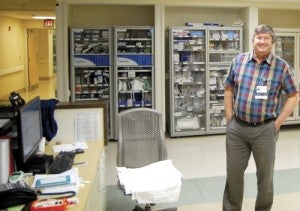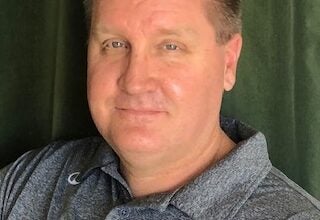Rowan Medical Center working to improve patients’ experience
Published 12:06 am Sunday, May 3, 2015

- Meredith Julian, a nurse in the emergency department at Rowan Medical Center, talks with Gerald Jennings while she gives him morphine Thursday. Jennings came to the hospital after he had fallen earlier in the day. One way the hospital is working to improve patient satisfaction is by having better communicaton between staff and patients.
By David Purtell
david.purtell@salisburypost.com
When someone has to go to a hospital, it’s rarely an in-and-out process.
Patients have to deal with everything from paperwork to long waits and the fear that comes with not knowing what’s wrong to the sudden shock of a diagnosis. And hospitals, where doctors and nurses exhaust their energy on long hours of multitasking and dealing with frustrated patients and families, are constantly trying to figure out better ways of making the whole process go smoothly for each patient.
Based on patient satisfaction surveys collected by Medicare, Novant Health Rowan Medical Center falls below the national average when compared with other hospitals. But officials with the hospital said they are working to improve patient satisfaction by focusing on communication, shortening wait times and making sure patients are well informed and treated with care.
The survey
Medicare started requiring hospitals to issue patient satisfaction surveys in 2007. And the federal government can withhold payments to hospitals if survey results are seen as unsatisfactory.
But the surveys aren’t a precise measure of a hospital’s quality. Not all patients get one and, in the case of Rowan Medical Center at least, most patients who do receive a survey after their stay do not return it. For the most recent data available, established using surveys issued from mid 2013 through mid 2014, only 21 percent of Rowan Medical Center patients who got one sent it back.
For Carolinas Medical Center-NorthEast in Concord, the response rate was 29 percent.
But the data can offer insight into specific aspects of a hospital. One question asks patients if they received help as soon as they wanted it. For Rowan Medical Center, 62 percent of respondents said they “always” got help as soon as they wanted it. For CMC Northeast, the figure is 68 percent, which is also the average for hospitals across North Carolina and the nation.
Other questions cover things such as nurse and doctor communication with patients, room cleanliness and pain control. Hospitals only get credit if a patient answers “always” to the questions — for example, my nurse always communicated well, my room was always clean.
For those types of questions, Patients can answer: never, sometimes, usually or always.
Another question asks patients if they would recommend their hospital to someone else. For Rowan Medical Center, 56 percent of respondents said “yes,” they would definitely recommend the hospital. For CMC-NorthEast, it’s 79 percent, above the state and national average of 71 percent.
In April, as a way to make it simpler for people to understand survey results, Medicare started converting the data into a five-star rating system. Rowan Medical Center got two out of five stars. CMC-NorthEast is rated four stars while Lake Norman Regional Medical Center got three stars.
Novant Health’s hospital in Huntersville got three stars while its one in Thomasville is rated two stars.
Caldwell said she takes the survey results seriously, but that the hospital would be working hard to make sure all patients have a good experience regardless of whether the surveys are part of the process.
She did say a downside to the survey is that, until recently, only patients who were discharged to their home received one — now those who go to assisted-living facilities receive one too. But those who go to a rehabilitation facility do not receive a survey.
Caldwell, who became the hospital’s president in 2010, said 85 percent of the hospital’s patients who take the survey answer “always” or “usually” on questions such as did a doctor or nurse listened well to the patient. But since Medicare only counts the “always” answers, the hospital doesn’t get credit for “usually.”
Getting better
Caldwell talked about several steps the hospital is taking to improve patient satisfaction.
She stressed the importance of hospital staff communicating with patients about what is happening in regards to their treatment.
Patients get upset when they’re sitting in a room wondering why things are taking so long, Caldwell said. As a remedy, hospital nurses meet with each of their patients at least once an hour. And each exam room has an information board that shows the name of the nurse or technician working with the patient and what the treatment plan is.
If a patient has to wait awhile, Caldwell said, nurses explain to them the reason for the wait.
Dr. Jack Byrnes, the new director of the hospital’s emergency department, said it’s crucial that patients are given a reason for why they have to wait.
He used the example of a contrast CT scan. Before the CT scan, patients drink a fluid that helps certain areas of the body show up better in the x-ray. But they have to wait an hour for the fluid to spread through their system. If someone doesn’t tell them why they are waiting, patients can get frustrated, Byrnes said.
“They don’t know what we’re doing, and they’re beginning to get upset because they don’t know,” he said.
Byrnes said its important for hospital staff to interact with patients and anticipate what questions they might have. “We try to internalize” the patient experience, he said, adding it can be difficult for doctors and nurses to manage, along with all the work they already do, a balance between treating the illness and treating the person.
For patients staying at the hospital overnight or for a few days, there is a poster in their room where they or a nurse can write information about the patient — where they are from, their job, hobbies, etc. This helps nurses and doctors get to know the patient better.
Every interaction between staff and patients shouldn’t be clinical in nature, Caldwell said, adding people want to be treated like human beings.
“We really try hard to identify with what the patient needs and what’s special about that patient — rather than just their diagnosis,” she said.
When a shift change comes, both nurses sit with the patient and talk about his or her treatment so everybody can be on the same page.
The hospital uses a system where someone in a patient’s family is designated as the person the nurses and doctors communicate with during each shift whether in person, by phone or email. This helps streamline the flow of information and minimize the frustration family members can feel when a loved one is in the hospital, Caldwell said.
Caldwell said she and other hospital officials visit with patients each day and listen to, and address, any concerns they may have.
Pain management is another area the Rowan hospital, along with ones across the country, is working to improve in. Patients are often asked what level, from one to 10, their pain is at. Byrnes and Caldwell said making sure pain is treated early on in the process is the goal.
Caldwell said there are three levels of patient suffering the hospital looks at: the diagnosis, all the things that go with the diagnosis — like side effects and treatment — and finally the bureaucracy of a hospital: waiting, delays and dealing with the healthcare system in general.
“We probably can’t change your diagnosis. We can try to make the treatment as easy as possible. But we certainly can affect the third level of suffering, and that’s what we’re really focusing our energy on,” Caldwell said.

Dr. Jack Byrnes is the new director of the emergency department at Novant Health Rowan Medical Center.
Emergency room is key
Dr. Byrnes is part of the new physician staff in Rowan Medical Center’s emergency department. His group, Valley Emergency Physicians, came to the department late last fall after Caldwell, in an effort to improve patient experience, ended the hospital’s contract with the Schumacher Group, which had been providing physicians to the department for seven years.
Caldwell said it was a difficult decision, but that there simply wasn’t enough progress being made. She said a national search was conducted by the hospital before Valley Emergency Physicians was chosen.
About 80 percent of patients who are admitted to Rowan Medical Center come through the emergency department — an average of 150 people a day.
To cut down on wait times in the ER, Byrnes said, patients are assessed by a nurse or physician assistant when they first come in, and if the issue can be handled quickly — someone slamming their finger in a car door for instance — it is. Byrnes said the goal is to separate the simpler cases from the ones that need more attention so things don’t get backed up.
Things have improved since Valley Emergency took over late last year, Caldwell said.
The hospital can see its survey scores, which are handled by a third party, on a rolling basis. Since January, the percentage of people who say they would recommend the hospital after visiting the emergency room has increased from 28.6 percent to 50 percent. Doctor approval scores are up too, from 40 percent to 63 percent in the same time period.
“We are very encouraged with the direction” we are heading, Caldwell said.
Aidan’s story
Tara Melton and her son 5-year-old son, Aidan, were at the Sonic drive-in March 23 when, suddenly, Aidan had a severe asthma attack.
Tara drove straight to the ER at Rowan Medical Center. Aidan had had a seizure and was unresponsive when they got there. She said the hospital staff went straight to work on Aidan and were able to get him stable.
“They were phenomenal,” Tara said about the doctors and nurses who worked with Aidan, adding she couldn’t have asked for better service.
They were at the hospital for about three hours, she said, and the whole time she and Aidan knew exactly what the doctors were doing.
The communication was great, Tara said. Nurses and doctors made a point of getting down and speaking to Aidan at his level so he could understand.
“I promise I’m not going to do anything that will hurt you without telling you first,” she said a nurse told Aidan before giving him an IV.
When a shift change came, both nurses sat and talked with Aidan, who ended up having to be transferred to the children’s hospital in Concord. Before transferring him, the nurses explained to Aidan what was going to happen, Tara said.
Aidan ended up being OK, she said.
Work left to be done
Chamberlain said she was later told that a nurse was fired as a result of that visit.
Hospital officials said they cannot comment on Chamberlain’s experience due to patient privacy laws.
Gerald Jennings, from China Grove, was lying in a hospital bed in the ER at Rowan Medical Center Thursday afternoon. The 82-year-old, who retired from the Air Force and still goes on long road trips in his Buick, had fallen earlier that morning and had pain in his left side. A nurse asked how his pain level was at the moment, and Jennings said he was hurting a little bit. Within a couple of minutes, he was given morphine.
Jennings said he has been treated at the hospital a few times recently. He had pneumonia not long ago.
“Nothing but good service,” he said about his time at the hospital, “Treated me real good.”
Contact Reporter David Purtell at 704-797-4264.




